New federal funding helps expand our fleet and service!
New federal funding helps expand our fleet and service!
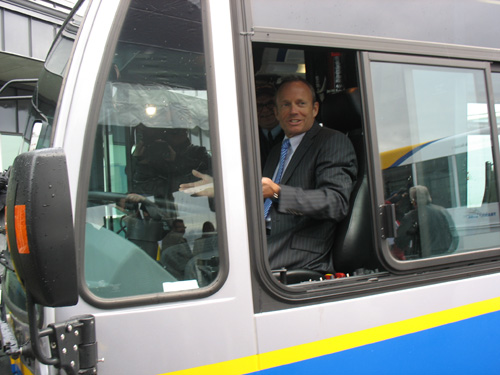
We held an event at the SeaBus maintenance centre today, and federal and municipal leaders helped us announce $186.4 million in new federal Gas Tax funding for TransLink over the next two years!
The new funding will support the purchases of:
- 146 conventional buses
- 34 articulated trolley buses
- 23 Community Shuttles
- 55 HandyDART buses
- 38 SkyTrain Mark II cars
As well, in 2009, the funding will provide $10 million for the $54 million SkyTrain Operations and Maintenance Centre expansion, and in 2010, the new Maintenance and Transportation Training Centre (MTTC) in Maple Ridge will receive $50 million of the nearly $165 million cost.
You can grab the full press release and backgrounder here for more info.
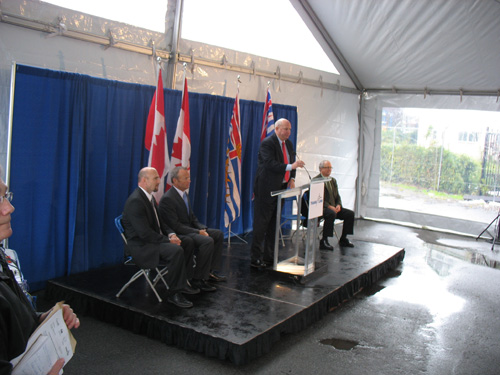
So far, we’ve received funding from the federal Gas Tax Revenue Fund for three years, since the program started in 2005. The fund sent gas tax money back to the provinces and supported capital projects that promote sustainability across the country. The Union of BC Municipalities has been instrumental in earmarking that funding for transportation in our region.
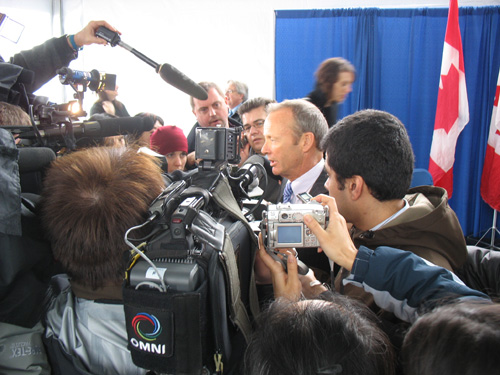
In the first three years of the program, we received $122.7 million, which bought us:
- 50 standard-sized buses powered by compressed natural gas (CNG)
- 361 standard clean diesel buses
- 16 60’ articulated clean diesel buses
- 21
60’ CNG articulated diesel buses60′ articulated hybrid diesel buses - 9 standard highway coaches
That funding let us add 220 more buses and replace 232 buses that had reached the end of their service lives. Plus, we were able to introduce low-floor accessible Nova buses to North Vancouver, and increase long-range bus service between downtown Vancouver and areas like White Rock, Boundary Bay and Steveston.
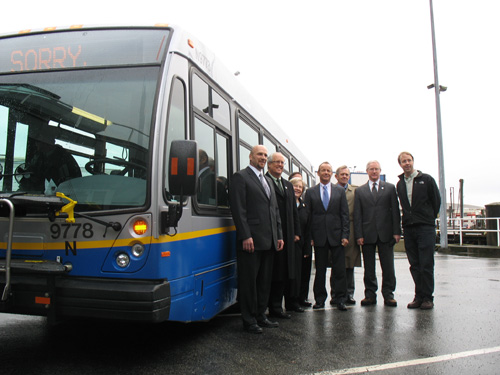
So, a big thanks to the federal government for their ongoing support of transportation in our region!
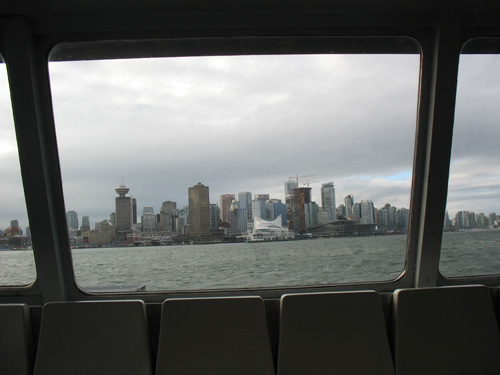
And last, here’s a gratuitous skyline shot from the SeaBus. Yes, I rode transit all the way to the event! Don’t you just love that our transit system involves boating on the open seas?
Edit:
After reading some of the comments and asking a few questions myself, I have a few clarifications about this new funding and how they relate to the vehicle orders. (I wrote this all out in the comments below too.)
To make sure we had buses and SkyTrain cars for our planned expansion, we had to make the orders more than a year ago. So that’s why we have been talking about those extra cars and buses coming down the pipeline already. We needed those vehicles so we made the order.
However, payment for those new buses and SkyTrain cars, however, was not precisely nailed down. We anticipated paying for the new vehicles the federal money from the gas tax fund, but until now, we weren’t quite certain how much exactly we would get to cover those costs. Now, we know exactly how much we’ve got ($186M) and we can now tell you exactly where it’s going to be spent (paying for all those buses and SkyTrain cars listed above). The event on Thursday was just a formal announcement to mark this contribution.
The obvious question now is: what if we didn’t get the federal gas tax funding? Well, that’s actually kind of the wrong question — we always knew we would get the federal gas tax money, it was just a question of how much. Since we needed the vehicles and they had such a long turnaround time, we had to make those orders over a year ago so they would arrive in 2009. But we knew the federal funding was definitely going to be there in some large way, and then we would cover the rest. And here we are today with $186M of our capital costs covered, thanks to the federal government.
I hope this makes sense! Thanks to the federal government again!






“Stockwell Day, Canada’s Minister of Public Safety, gets behind the wheel of one of our low-floor trolleys.”
Actually, the vehicle is a NovaBus low-floor diesel bus, judging from the appearance of the front end.
Dear Lord, my brain is going. Thanks for the correction Alex!
21 60’ CNG articulated diesel buses
This information has GOT to be incorrect. CNG AND diesel in one coach?
My understanding is that we are ordering hybrid (i.e. diesel/electric) artics.
Jhenifer,
I’m not clear from the announcement. Is this announcing federal funding to support the existing order of 34 articulated trolley buses and the existing order for 38 (which I thought was 48) Mark II SkyTrain cars, or is this an additional order (34 additional trolley buses over and above what has already been ordered by Translink)?
Um, is there anything new here? Are these 38 SkyTrain cars over and above the ones that are starting to arrive now or is this another government “re-announcement”?
Shane:
Well, what’s new is the actual funding itself. That $186 million hadn’t yet been committed to us, and now it is. Also, the 38 SkyTrain cars referred to are indeed part of the 48 SkyTrain cars originally ordered. So the “new” part in that respect is that the funding for those cars is secured.
David:
Basically the answer to your question is much the same as I wrote for Shane above. The funding pays for 38 of the 48 SkyTrain cars that have already been ordered, and the existing trolley bus order. What’s new is the money being committed for sure. Which is maybe not the hugest news, but a big deal to us for sure. Funding for transportation = good!
Derek:
You are likely right about that. I’ll ask somebody in fleet procurement for the answers sure.
Derek:
Just confirmed. You are totally right – those are the hybrid diesel buses arriving in 2009. I’ll correct the post. Sorry about that too — I was working off the release, which I assumed had the correct info in it!
I also want to ask why Translink & CMBC are scrapping at a high rate, so many “older” buses that are still being used across North America, Like the MCI Classics (The 4100 & 4200 Series) Ant the New Flyer D40’s (The 3100 & 3200 Series) A lot of these coaches are much better than the new nova’s or new trolleys. (many issues that i can see as a passenger. And horror stories I hear from drivers) That is a total of almost 400 buses getting replaced or scraped. I know they are high floors and such but they hold more people and I kind of find it funny with SkyTrain & the SeaBus they already had the money to buy the new equipment. The news release is really not sitting well with me right now. Can i please get an answer why TransLink is getting rid of almost all ex-BC Transit buses we have in the fleet.
Hi Dan,
I talked to the folks in fleet procurement and here’s the response they’ve sent along regarding your questions about the older buses.
Our fleet is currently 100% accessible; the high floor buses currently in service all have wheelchair lifts. That said, high floors present significant mobility challenges for the public.
A few quick notes:
-The MCI buses have all been retired, with the most recent model year being 1990.
-The New Flyer D40 buses are from 1991-1992. They are 17-17 years old, tired, and worn. They are loud. They have a harsh ride quality. They pollute heavily. Their fuel consumption is roughly 25% higher than more modern buses. Most of them have over a million kilometers on their frames. Their engines have developed problems and a significant number are in need of partial or full rebuilds. Their reliability has weakened.
In the US, they typically replace old buses when they reach about 12 years of age. BC Transit was one of the leaders in buying low-floor accessible buses. As recently as two years ago, I heard that New Flyer was still building D40 high-floor buses for customers who demanded them. It’s possible to keep old buses running indefinitely, but it starts to cost a lot of money in parts and labour to keep them on the road– so much so that it’s worth buying new vehicles. For example, with the trolley buses we sold to Mendoza, Argentina, we kept them maintained and safe while they were in service, but the new trolleys only need one third the amount of maintenance.
In terms of seating capacity:
D40: 40
D40LF:38 (low floor buses bought between 1996 and 2001)
Nova: 35 – seating capacity is lower due to the bus being low-floor
(wheel wells poke into space that would be used for seats on a high floor bus), plus we have an extra-wide rear door to make it easier for passengers to disembark, plus they have a rear-facing wheelchair position which speeds up loading/unloading of wheelchairs, though it removes a few seats.
2009 Nova Hybrid: 36
Passenger capacity:
D40: 77
D40LF:77
Nova: 82
2009 Nova hybrid: 73 – reduced space for standees due to new
configuration
For your complaints or issues with the Nova buses (or other new buses), you are strongly encouraged to let us know about them. We can either provide answers why things are as they are, or try to fix the problem if it is fixable, or improve the issues in future bus orders. (Feel free to contact Customer Relations with those issues via (604) 953-3040 or this feedback form, or just email me if you want.)
One complaint I have with the low floor buses the lack of physical mark on where NOT to stand.
On Skytrain, it was amazing how many people like to stand with their friends chatting away face to face blocking the doors. They expect others to walk around or use another door.
With the low floor buses, large groups now congregate at the doors so they can chat with one another blocking the “wider” doors. I’d like to see something painted on the ground to discourage people from blocking the exits. In the old days the physical steps or a swing door (70’s) discourage groups from standing there. We need something like that again.
Thanks xl, I’ll pass that comment on.
Jhenifer,
I cant help but respond to say that TranslInk will put the D40’s as a “rough ride” They are probably one of the most smoothest buses to ride on as well were the MCI Classics and are actually very comfy and enjoyable. and also have working heaters! But in regards to the “engine trouble” the D40s have been more reliable then any of the newer buses. I dont understand why translink doesn’t rebuild the buses at $100,000 (the cost to rebuild one) then trash them. I know the W/C Lifts are breaking down constantly but that is due to many issues i have seen over the years as riding transit on “misuse” And i think it was back in 2004, TransLink stopped ordering parts for the W/C Lift. Have a good weekend.
For everyone: I actually have a few clarifications about the funding and the orders. I’ll put them up in the main post after I write this out.
To make sure we had buses and SkyTrain cars for our planned expansion, we had to make the orders more than a year ago. So that’s why we made those orders and have been talking about those extra cars and buses coming down the pipeline already (the 48 SkyTrain cars, community shuttles etc).
However, payment for those new buses and SkyTrain cars, however, was not precisely nailed down. We anticipated paying for the new vehicles the federal money from the gas tax fund, but until now, we weren’t quite certain how much exactly we would get to cover those costs. Now we know exactly how much we’ve got ($186M) and we can now tell you exactly where it’s going to be spent (paying for all those buses and SkyTrain cars listed above). The event on Thursday was just a formal announcement to mark this contribution.
The obvious question now is: what if we didn’t get the federal gas tax funding? Well, that’s kind of the wrong question — we always knew we would get the federal gas tax money, it was just a question of how much. Since we needed the vehicles and they had such a long turnaround time, we had to make those orders over a year ago so they would arrive in 2009. But we knew the federal funding was definitely going to be there in some large way, and then we would cover the rest. And here we are today with $186M of our capital costs covered, thanks to the federal government.
I hope this makes sense!
It’s great to hear that TransLink has funding to expand service. It’ll be nice to see more frequent service, as well as being able to see articulated trolleys running on more routes.
I’d also like to comment on the older D40 buses. Basically, if they work fine, why retire them all at once? If they’re in desperate need of replacement, then do that. But if they just need a few replacement parts, it’s still cheaper than to buy a new bus; keep them in service for a few more years. In my opinion, while they do have their disadvantages, they do give a very comfortable ride, and have more seats, among other advantages. They are also no louder than the D40LFs.
If we’re already having some problems with overcrowded, delayed and/or infrequent bus service, why not have a mega-fleet with both the old and new buses running – not just during the Olympics in 2010, but after it for a while as well.
Thanks for your time.
[…] Hijacking the information highway [Common Ground] New federal funding helps expand our fleet and service! [Buzzer Blog] 2010 Fortress, Backer of Key 2010 Sites, Is ‘Teetering’ [The Tyee] City […]
Jennifer, thanks so much for checking with folks on the inside to get responses for your readers.
Can I ask if the total 48 SkyTrain cars means 48 pairs, or is that 24 pairs?
Thanks!
Shane:
Wow, sorry for the delay on this one! The 48 SkyTrain cars means 24 pairs. Hope that helps!
In the purchase plan, i suggest Translink to purchase some New Flyer Hybrid and/or Diesel buses to expand and replace the fleet. Since Translink has purchased TOO MUCH NOVA in Vancouver, New Flyer should be a consideration of next purchase plan. Here are some models I will suggest to Translink:
– New Flyer DE40LFR Hybrid Bus
– New Flyer Xcelsior Hybrid Bus
– New Flyer D40LFR
I stumbled upon this after checking out CMBC on Wikipedia. I was astonished to discover so many older buses being scrapped while the long term transit plan calls for more buses and the current “more buses now” campaign. Okay, the old buses are not 100% accessible. So what? Use these buses for rush hour service to fill in around the accessible buses. If able bodied people can get on the old bus, that relieves some crowding and people needing the accessible bus may have a better chance of not being passed up. Don’t reduce the levels of the current accessible buses, just use the old ones to fill in the gaps. Any harm in this? Is it better to be able to say “we’re 100% accessible” rather than actually moving people? If the long term plan is to replace these buses, then great but in the mean time, use them!
Hi Marvin,
Accessibility isn’t the only reason we are retiring older buses. Older buses have much more wear and tear and take far more work to maintain, which means they can be much more expensive to service and keep on the roads, and are much less reliable when in service. Typically, Canadian buses see roughly ~17-18 years of service before being retired, so we do get a lot of work out of them. For example with the trolleys, the old ones were roughly 25 years old with a lot of wear and tear — while the new trolleys will last another two decades and take 1/3 of the maintenance time, meaning more time on the road and less time in the shop!
As well, if you’re curious about the maintenance work that Coast Mountain Bus does too, check out the series I wrote on Fleet Overhaul, the vehicle maintenance centre in Burnaby.
DLPPROJECTORDUBAIPRICES…
[…]just below, are some totally unrelated sites to ours, however, they are definitely worth checking out[…]…